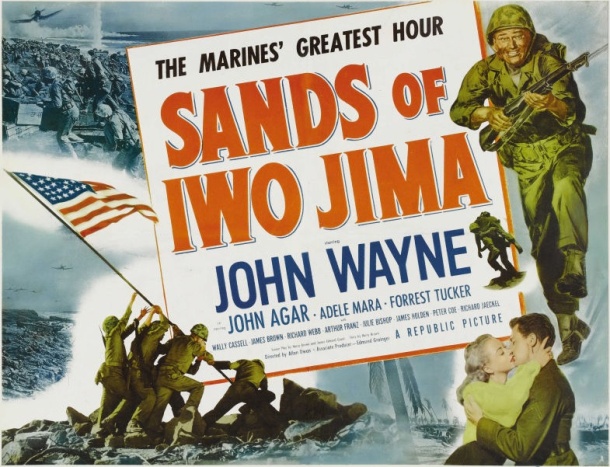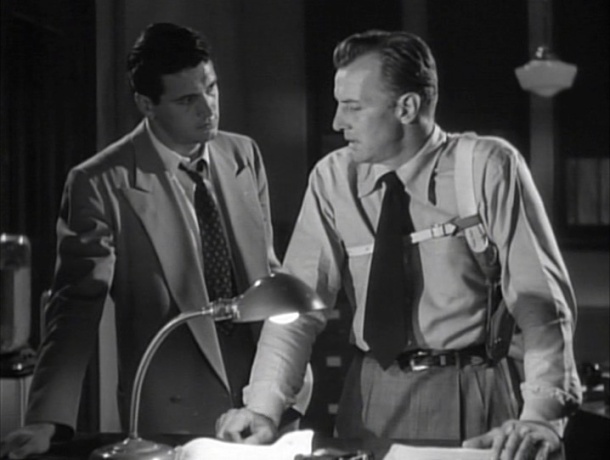
Sands of Iwo Jima (1949)
Directed by Allan Dwan
Republic Pictures
In my recent review of Battleground (1949), I discussed whether or not it should be seen as an “anti-war film.” I absolutely don’t think that it should be, but I do think that it’s a sensitive portrait of the stress and fear that the “battered bastards of Bastogne” experienced during the Battle of the Bulge.
In my review of Battleground I also argued that it was not the first film about World War II to depict soldiers as three-dimensional people who experience fear and doubt, even though plenty of reviews claim that it was. But the depth of the characterizations made Battleground a significant war movie, and the fact that it was the first major war movie released after the end of World War II was significant, too.
However, shortly after the release of Battleground came a movie not about soldiers, but about marines, and it’s exactly the kind of movie people are imagining when they call Battleground a “revisionist” war movie or an anti-war film.
I really enjoyed Sands of Iwo Jima, but with its gung-ho attitude towards war, heroism, manhood, and patriotism, it’s diametrically opposed to Battleground. Just about the only things the two movies have in common are that they’re both about World War II, and both feature Richard Jaeckel in a small role.
Sands of Iwo Jima stars John Wayne as the alcoholic, tough-as-nails leatherneck Sgt. John M. Stryker. As his ass-kicking surname implies, Sgt. Stryker is the kind of non-com who doesn’t care if his men like him; he only cares about whipping them into a fighting force that thinks and moves as one man so they can give the Japs hell. During training, one of the marines looks at Stryker and growls, “I don’t know which I hate worse, him or the Nips.”
John Wayne received his first Oscar nomination for best actor for this film. I’ve heard that Wayne felt he should have been nominated for She Wore a Yellow Ribbon (1949) instead, but I thought his performance in that film was overly affected. His role in Sands of Iwo Jima played much better to his strengths.
The human drama in the film focuses on PFC Peter Conway (John Agar), whose father served under Sgt. Stryker. Conway comes from a family with a long tradition of service in the US Marine Corps, and when Stryker talks, all Conway can hear is his father.
There’s humor in Sands of Iwo Jima, but most of it comes in the form of macho posturing. There are the Flynn brothers (played by Richard Jaeckel and William Murphy), two PFCs who can’t go a day without getting in a fistfight. And there’s a scene where a sailor tries to cut in on Conway’s slow dance with a pretty blonde named Allison Bromley (Adele Mara), and he snaps, “Shove off, Mac.” (Take that, US Navy! You can give the USMC a ride to the battle, but don’t step on their toes, punks.)
But the high point of Sands of Iwo Jima are the elaborate battle scenes, which take place in two sections; first the assault on Tarawa and then the assault on Iwo Jima.
When an officer is showing the men a map of an island that is part of the Tarawa atoll, he says, “Don’t ask me how you spell it. You’ll have to stick your faces into it, but you don’t have to spell it.” He goes on to tell them that the Japanese troops are dug in pretty deep. “They’d just as soon die as stick a nickel in a jukebox. But that’s all right. Let the other guy die for his country. You live for yours!”
The action is fast and furious, which is appropriate, since this film depicts some of the fiercest and bloodiest battles of World War II.
Sands of Iwo Jima was produced by Republic Pictures, which mostly made lower-budgeted films, so it doesn’t have the high production values that MGM brought to Battleground. The battle scenes in Sands of Iwo Jima incorporate a good deal of newsreel footage, which adds some authenticity to the film, but occasionally makes the newly filmed segments look a little fake. The filmmakers did as well as they could. The special effects were by Waldo and Theodore Lydecker, who did fantastic work in numerous Republic serials, and the demolition effects were carried out by the USMC. But the newsreel footage of actual fighting occasionally took me out of the picture by reminding me that most of what I was seeing was a Hollywood recreation.
Not long after Sands of Iwo Jima was released, Henry King’s Twelve O’Clock High (1949) hit theaters. It was the third major film about World War II released in 1949, several years after the war had ended. Battleground was significant for being the first, but three makes a pattern, and shows that after a few years of tranquility on the silver screen, audiences were once again hungry for simulated wartime mayhem. (A more cynical view might be that Hollywood was ginning up support for the coming conflict in Korea.)















